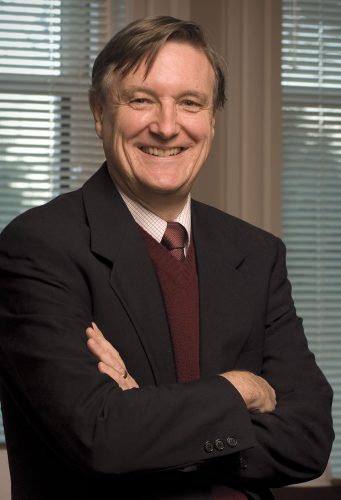“I had no idea what I wanted to do—what does a computer scientist do with forests?”
As it turns out, John Aber (BK ‘71, M.F.S. ‘73, PhD ‘76), professor in the Department of Natural Resources and Environment at the University of New Hampshire (UNH), was able to couple his passion for forestry with computer science. He earned his undergraduate degree in applied engineering at a time when the computer science major at Yale did not even exist, computer resources were logged via paper punch cards, and supercomputers occupied entire rooms. He went on to get master’s and doctorate degrees at the Yale School of Forestry and Environmental Sciences, where he was able to start his work in computational forestry.
Aber recalls being in New Haven in 1970 for the first Earth Day celebration, when he first realized the potential of environmental science as a field of research and scientific study. Faculty in the School of Forestry and Environmental Science had recently begun to define the study of ecosystems. “The word ecosystem was new at that time, and studying whole ecosystems was even newer. It was very exciting to be part of the start of a new discipline,” Aber said.
Aber’s expertise in computer science provided him with a crucial tool to begin research in the field. As a graduate student in Yale’s School of Forestry and Environmental Studies, he worked with a mentor, Daniel Botkin, who wanted to join the fields of forest ecology and computational studies. One of the topics Aber most enjoyed conducting research on at the time was nitrogen saturation and cycling through the lens of biogeochemistry. “What would happen if we changed the level of nitrogen in a system? How would that affect forest growth?” Aber questioned.
To answer this question and others about acid rain, he completed his postdoctoral studies at the Hubbard Brook Ecosystem Study in New Hampshire, where Professor F Herbert Bormann proved an inspirational mentor. Through this research, Aber was able to collaborate with forestry research groups from across the world, using remote sensing and modeling to make inferences about what Aber termed the “integrated physiology of forests.”
After a year at the University of Virginia, Aber moved to the University of Wisconsin-Madison’s Forestry Department in 1978. He became the first Director of their Center for Restoration Ecology in 1986, pursuing ecology as a study of history. “Everything you see in a forest today is the product of hundreds of years of growth and change,” Aber explained. “In many areas, there is no need to restore a forest—if it is cut down, it will begin to grow back by itself. Nature can be resilient.”
After a decade in administration, he returned in 2013 to research at UNH, focusing on sustainable agriculture. Aber was aided by the organic dairy research farm at UNH, the only one in the country. “For many years, the focus of studies at UNH was environmental studies in the largest sense. I feel so lucky to have been able to work at a place like UNH,” he explained. Aber found that this field of research was dominated by the industry, and he thought it was important to encourage the “bottom-up reclamation of local food through farmer’s markets and sustainable local produce.” He noted that this has taken shape already—especially in New England, with many local farmers’ markets.
Looking towards the future, Aber hopes to see federal-level implementation of research on climate change. “We have done the research, we know the systems, and we know their implications,” He paused, and continued, “It’s all very clear scientifically, but as long as we try to pretend it’s not happening, we can’t be ready.”
Having conducted more than forty years of research in forestry, Aber was able to combine two fields to become a pioneer. He laid the groundwork for future scientists who hope to bring together distant topics of interest, giving the world a new perspective on important issues. He has also served as a mentor for dozens of students, altering their lives in the same way his mentors did. Aber, however, gives the most credit to the people who have helped him along his journey. “At every single step, there were people who really made the difference,” he said. “Your colleagues become lifelong collaborators and partners.”

